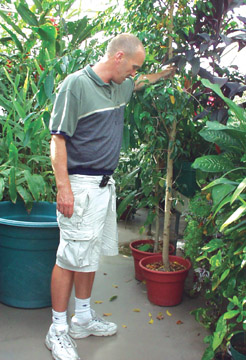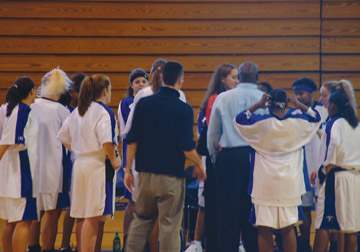When Two Worlds Collide

Jim Allen examining the flora of the UMB Greenhouse. – photo by Mimi Yeh
August 29, 2003
For incoming students who are unfamiliar with the winding hallways of UMass it can be difficult finding places to relax and unwind. Yet nowhere do harmony and cacophony come together so completely as they do at the UMB Greenhouses. Created as an adjunct to the Biology Department, they are run by the ever busy, seemingly omnipresent Jim Allen. Allen can frequently be seen around campus arranging, watering, or carting around a constantly changing army of plants.
Originally from UMass Extension School working studying and treating invasive and diseased plants, Allen has been tending the foliage of UMass Boston for seven years now, keeping a combination aviary-aquarium-plant nursery. With a canary and several species of common parakeets to keep him company, a row of fighting fish in their individual bowls, and his own press clippings lining the bottom of their cages, he is the residing authority on the campus seeing the plaza as “one big roof-top garden.”
The Greenhouse, with its three rooms designated for temperate and tropical plants besides a small section of arid-oriented species, is designed to exemplify the diversity of the plant kingdom and “provide plants that can educate.” A majority of the plants have been there thirty years or more. Some are innately interesting, like the carrion flower, which I had a chance to smell (can you guess the scent?), while others have interesting stories behind them. The term “economic botany” may be applied to the elder plants in the greenhouse, like the coffee bean bushes and the chocolate tree, relics from the 1970s and a past head who was concerned with the value of plants and their use, preferring something more than just another pretty face. The South African Xenophus swimming in the tanks act as model organisms for students studying genetics.
Most of Allen’s visitors are science majors and school children with the intermittent art student added to the mix every now and again. The most common question is, “Where is your hallucinogenic plant group?” to which he can only shake his head. The noisy, frenetic atmosphere of the Greenhouse generally eases once the birds get comfortable with the visitors. If you’re nice, he’ll even let you pet one of the birds. As I sat there, I noticed a slug crawling around one of the potted plants and pointed it out. Allen took it and dropped it into the fish-tank nearby. Nothing goes to waste there.
Some people are unaware of the fact that UMass Boston is situated on top of a capped landfill, meaning that most of the soil has to be brought in from elsewhere. The soils are derived from bagged mixes made up of peat moss, vermiculite, etc. But if Allen can get it elsewhere, he does, preferring to use leaf compost from Boston, saying that such mixes are only gained from mining the pristine environments of the peat bogs. The complications that arise from working in such a tough ecological area do not bother him, however. It takes innovation to create a unique pairing of traits: the hardy and the aesthetically pleasing.
Most of the plants grown on campus and repotted are stored on a terrace-like area right outside of the Greenhouses. Cannas, the orange plants used on municipal projects and community gardens, line the rooftop, leaning ever so slightly. Here, all species of plant and some amphibian proliferate until it is time to bring them in. It’s never quiet either, with the croaking of the frogs drifting in every so often once the birds have fallen silent.
Keeping a variety of plants like that at home would require one to give up eating and sleeping but there are easier species that will brighten up a place without needing too much attention. For example, the Spathiphyllum, or “peace lilly” will even survive in most office cubicles. A ficus can survive just about any amount of neglect. Most people’s problems have to do with “loving plants to death,” states Allen. Owners will give it sporadic care and either over- or under-water their leafy companions. The key is to find a plant that has a high toleration to drought stress and over-saturation.
Allen welcomes all visitors to the Greenhouse, located on the fourth floor of the Science Building, open from 9am to 4pm. Interested students may also look online at www.greenhouse.bio.umb.edu for more details.






















































